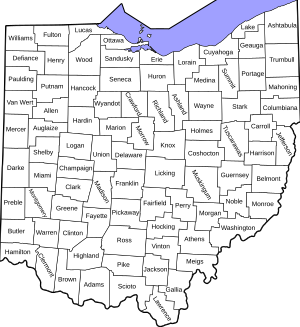County
|
FIPS code[10]
|
County Seat[11]
|
Est.[12]
|
Origin[13]
|
Etymology[12][13]
|
Population
(2023)[10][11][14]
|
Area[11]
|
Map
|
| Adams County
|
001
|
West Union |
Jul 10, 1797 |
Hamilton County |
John Adams (1735–1826), President of the United States when the county was organized
|
27,521
|
583.91 sq mi
(1,512 km2) |

|
| Allen County
|
003
|
Lima |
Mar 1, 1820 |
Shelby County |
John Allen (1771/2-1813), a War of 1812 colonel[15]
|
100,838
|
404.43 sq mi
(1,047 km2) |

|
| Ashland County
|
005
|
Ashland |
Feb 24, 1846 |
Wayne, Richland, Huron, and Lorain Counties |
Ashland, home of U.S. Senator from Kentucky Henry Clay
|
52,190
|
424.37 sq mi
(1,099 km2) |

|
| Ashtabula County
|
007
|
Jefferson |
Jun 7, 1807 |
Trumbull and Geauga Counties |
Ashtabula River, which means "fish river" in an Algonquian language[16]
|
96,845
|
702.44 sq mi
(1,819 km2) |

|
| Athens County
|
009
|
Athens |
Mar 1, 1805 |
Washington County |
Athens in Greece
|
62,706
|
506.76 sq mi
(1,313 km2) |

|
| Auglaize County
|
011
|
Wapakoneta |
Feb 14, 1848 |
Allen, Mercer, Darke, Hardin, Logan, Shelby, and Van Wert Counties |
Auglaize River, which means "fallen timbers river" in the Shawnee Indian language
|
46,050
|
401.25 sq mi
(1,039 km2) |

|
| Belmont County
|
013
|
St. Clairsville |
Sep 7, 1801 |
Jefferson and Washington Counties |
French for "beautiful mountain"
|
64,918
|
537.35 sq mi
(1,392 km2) |

|
| Brown County
|
015
|
Georgetown |
Mar 1, 1818 |
Adams and Clermont Counties |
General Jacob Brown (1775–1828), an officer of the War of 1812
|
43,777
|
491.76 sq mi
(1,274 km2) |

|
| Butler County
|
017
|
Hamilton |
May 1, 1803 |
Hamilton County |
General Richard Butler (1743–1791), killed at the Battle of the Wabash
|
393,043
|
467.27 sq mi
(1,210 km2) |

|
| Carroll County
|
019
|
Carrollton |
Jan 1, 1833 |
Columbiana, Stark, Harrison, Jefferson, and Tuscarawas Counties |
Charles Carroll (1737–1832), last surviving signer of the United States Declaration of Independence
|
26,758
|
394.67 sq mi
(1,022 km2) |

|
| Champaign County
|
021
|
Urbana |
Mar 1, 1805 |
Greene and Franklin Counties |
French for "a plain", describing the land in the area
|
38,845
|
428.56 sq mi
(1,110 km2) |

|
| Clark County
|
023
|
Springfield |
Mar 1, 1818 |
Champaign, Madison, and Greene Counties |
General George Rogers Clark (1752–1818), defeated the Shawnee Indians in a battle near the Springfield area
|
134,610
|
399.86 sq mi
(1,036 km2) |
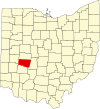
|
| Clermont County
|
025
|
Batavia |
Dec 6, 1800 |
Hamilton County |
French for "clear mountain"
|
211,972
|
451.99 sq mi
(1,171 km2) |
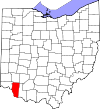
|
| Clinton County
|
027
|
Wilmington |
Mar 1, 1810 |
Highland and Warren Counties |
George Clinton (1739–1812), vice-president when the county was organized
|
41,938
|
410.88 sq mi
(1,064 km2) |

|
| Columbiana County
|
029
|
Lisbon |
May 1, 1803 |
Jefferson and Washington Counties |
Christopher Columbus, European explorer of the Americas
|
100,182
|
532.46 sq mi
(1,379 km2) |

|
| Coshocton County
|
031
|
Coshocton |
Jan 31, 1810 |
Muskingum and Tuscarawas Counties |
Delaware Indian word meaning "union of waters"
|
36,869
|
564.07 sq mi
(1,461 km2) |

|
| Crawford County
|
033
|
Bucyrus |
Apr 1, 1820 |
Delaware County |
Colonel William Crawford (1732–1782), Revolutionary War officer
|
41,529
|
402.11 sq mi
(1,041 km2) |

|
| Cuyahoga County
|
035
|
Cleveland |
Jun 7, 1807 |
Geauga County |
Cuyahoga River, which means "crooked river" in an Iroquoian language[17]
|
1,233,088
|
458.49 sq mi
(1,187 km2) |

|
| Darke County
|
037
|
Greenville |
Jan 3, 1809 |
Miami County |
General William Darke (1736–1801), Revolutionary War officer
|
51,415
|
599.80 sq mi
(1,553 km2) |
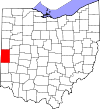
|
| Defiance County
|
039
|
Defiance |
Apr 7, 1845 |
Williams, Henry, and Paulding Counties |
Fort Defiance, built in 1794 by General Anthony Wayne
|
38,315
|
411.16 sq mi
(1,065 km2) |
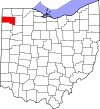
|
| Delaware County
|
041
|
Delaware |
Apr 1, 1808 |
Franklin County |
Delaware Indians
|
231,636
|
442.41 sq mi
(1,146 km2) |

|
| Erie County
|
043
|
Sandusky |
Mar 15, 1838 |
Huron and Sandusky Counties |
Erie Indians
|
74,035
|
254.88 sq mi
(660 km2) |

|
| Fairfield County
|
045
|
Lancaster |
Dec 9, 1800 |
Ross and Washington Counties |
Named for the beauty of its "fair fields"
|
165,360
|
505.11 sq mi
(1,308 km2) |

|
| Fayette County
|
047
|
Washington Court House |
Mar 1, 1810 |
Ross and Highland Counties |
Gilbert du Motier, marquis de La Fayette, French military officer and aristocrat who participated in both the American and French revolutions
|
28,817
|
406.58 sq mi
(1,053 km2) |

|
| Franklin County
|
049
|
Columbus |
Apr 30, 1803 |
Ross and Wayne Counties |
Benjamin Franklin (1706–1791), Founding Father, author, printer, political theorist, scientist, inventor, and statesman
|
1,326,063
|
539.87 sq mi
(1,398 km2) |
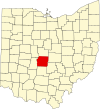
|
| Fulton County
|
051
|
Wauseon |
Apr 1, 1850 |
Lucas, Henry, and Williams Counties |
Robert Fulton (1765–1815), inventor of the steamboat[18]
|
42,007
|
406.78 sq mi
(1,054 km2) |

|
| Gallia County
|
053
|
Gallipolis |
Apr 30, 1803 |
Washington and Adams Counties |
Gaul, the ancient name of France
|
28,986
|
468.78 sq mi
(1,214 km2) |

|
| Geauga County
|
055
|
Chardon |
Mar 1, 1806 |
Trumbull County |
A native american word meaning "raccoon"
|
95,407
|
403.66 sq mi
(1,045 km2) |

|
| Greene County
|
057
|
Xenia |
May 1, 1803 |
Hamilton and Ross Counties |
General Nathanael Greene (1742–1786), Revolutionary War officer
|
169,691
|
414.88 sq mi
(1,075 km2) |

|
| Guernsey County
|
059
|
Cambridge |
Mar 1, 1810 |
Belmont and Muskingum Counties |
Island of Guernsey, from where most of the settlers originated
|
38,089
|
521.90 sq mi
(1,352 km2) |

|
| Hamilton County
|
061
|
Cincinnati |
Jan 2, 1790 |
One of the original counties |
Alexander Hamilton (1755/7-1804), Secretary of the Treasury when the county was organized
|
827,058
|
407.36 sq mi
(1,055 km2) |
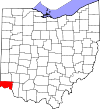
|
| Hancock County
|
063
|
Findlay |
Apr 1, 1820 |
Logan County |
John Hancock (1737–1793), president of the Continental Congress
|
74,704
|
531.35 sq mi
(1,376 km2) |
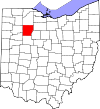
|
| Hardin County
|
065
|
Kenton |
Apr 1, 1820 |
Logan County |
General John Hardin (1753–1792), Revolutionary War officer
|
30,368
|
470.29 sq mi
(1,218 km2) |

|
| Harrison County
|
067
|
Cadiz |
Feb 1, 1813 |
Jefferson and Tuscarawas Counties |
General William Henry Harrison (1773–1841), an officer of the War of 1812 and future President of the United States
|
14,159
|
403.53 sq mi
(1,045 km2) |

|
| Henry County
|
069
|
Napoleon |
Apr 1, 1820 |
Shelby County |
Patrick Henry (1736–1799), Revolutionary War-era legislator, orator, and scholar
|
27,520
|
416.50 sq mi
(1,079 km2) |
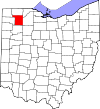
|
| Highland County
|
071
|
Hillsboro |
May 1, 1805 |
Ross, Adams, and Clermont Counties |
Descriptive of the county's terrain
|
43,614
|
553.28 sq mi
(1,433 km2) |

|
| Hocking County
|
073
|
Logan |
Mar 1, 1818 |
Athens, Ross, and Fairfield Counties |
Possibly derived from the Delaware Indian word "Hoch-Hoch-ing", meaning "bottle"
|
27,540
|
422.75 sq mi
(1,095 km2) |

|
| Holmes County
|
075
|
Millersburg |
Jan 20, 1824 |
Coshocton, Wayne, and Tuscarawas Counties |
Major Andrew Holmes (died 1814), a War of 1812 officer
|
44,386
|
422.99 sq mi
(1,096 km2) |

|
| Huron County
|
077
|
Norwalk |
Mar 7, 1809 |
Portage and Cuyahoga Counties |
Huron Indians
|
58,199
|
492.69 sq mi
(1,276 km2) |

|
| Jackson County
|
079
|
Jackson |
Mar 1, 1816 |
Scioto, Gallia, Athens, and Ross Counties |
General Andrew Jackson (1767–1845), future President of the United States
|
32,606
|
420.28 sq mi
(1,089 km2) |

|
| Jefferson County
|
081
|
Steubenville |
Jul 29, 1797 |
Washington County |
Thomas Jefferson (1743–1826), Vice President when the county was organized, future President of the United States, and principal author of the Declaration of Independence
|
64,026
|
409.61 sq mi
(1,061 km2) |
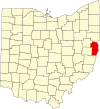
|
| Knox County
|
083
|
Mount Vernon |
Mar 1, 1808 |
Fairfield County |
General Henry Knox, the first Secretary of War
|
63,320
|
527.12 sq mi
(1,365 km2) |

|
| Lake County
|
085
|
Painesville |
Mar 6, 1840 |
Geauga and Cuyahoga Counties |
Its location on Lake Erie
|
231,640
|
228.21 sq mi
(591 km2) |
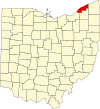
|
| Lawrence County
|
087
|
Ironton |
Dec 21, 1815 |
Gallia and Scioto Counties |
Captain James Lawrence (1781–1813), naval hero in the War of 1812
|
56,118
|
454.96 sq mi
(1,178 km2) |

|
| Licking County
|
089
|
Newark |
Mar 1, 1808 |
Fairfield County |
Licking River, named for the salt licks in the area, or an English pronunciation of the Lenape word W'li/'ik'/nk meaning "where the flood waters recede"[19]
|
183,201
|
686.50 sq mi
(1,778 km2) |
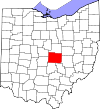
|
| Logan County
|
091
|
Bellefontaine |
Mar 1, 1818 |
Champaign County |
General Benjamin Logan (c. 1742 – 1802), who destroyed Shawnee Indian towns in the county
|
46,057
|
458.44 sq mi
(1,187 km2) |

|
| Lorain County
|
093
|
Elyria |
Dec 26, 1822 |
Huron, Cuyahoga, and Medina Counties |
Province of Lorraine, France
|
317,910
|
492.50 sq mi
(1,276 km2) |

|
| Lucas County
|
095
|
Toledo |
Jun 20, 1835 |
Wood, Sandusky, and Huron Counties |
Robert Lucas (1781–1853), Governor of Ohio when the county was created
|
425,484
|
340.46 sq mi
(882 km2) |

|
| Madison County
|
097
|
London |
Mar 1, 1810 |
Franklin County |
James Madison (1751–1836), fourth President of the United States
|
44,602
|
465.44 sq mi
(1,205 km2) |

|
| Mahoning County
|
099
|
Youngstown |
Mar 1, 1846 |
Columbiana and Trumbull Counties |
Mahoning River, from a Lenape word meaning "at the licks"
|
225,596
|
415.25 sq mi
(1,075 km2) |

|
| Marion County
|
101
|
Marion |
Apr 1, 1820 |
Delaware County |
General Francis Marion (1732–1795), lieutenant colonel in the Continental Army and later brigadier general in the American Revolutionary War
|
64,851
|
403.84 sq mi
(1,046 km2) |

|
| Medina County
|
103
|
Medina |
Feb 18, 1812 |
Portage County |
Medina, world-renowned religious site in western Saudi Arabia
|
184,042
|
423 sq mi
(1,096 km2) |

|
| Meigs County
|
105
|
Pomeroy |
Apr 1, 1819 |
Gallia and Athens Counties |
Return Jonathan Meigs Jr. (1764–1825), Governor of Ohio and Postmaster General at the time the county was organized
|
21,767
|
429.42 sq mi
(1,112 km2) |
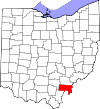
|
| Mercer County
|
107
|
Celina |
Apr 1, 1820 |
Darke County |
General Hugh Mercer (1726–1777), a Revolutionary War officer
|
42,439
|
463.27 sq mi
(1,200 km2) |

|
| Miami County
|
109
|
Troy |
Mar 1, 1807 |
Montgomery County |
Miami Indians
|
110,876
|
407.04 sq mi
(1,054 km2) |

|
| Monroe County
|
111
|
Woodsfield |
Jan 29, 1813 |
Belmont, Washington, and Guernsey Counties |
James Monroe (1758–1831), Secretary of State when the county was organized and future President of the United States
|
13,153
|
455.54 sq mi
(1,180 km2) |
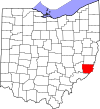
|
| Montgomery County
|
113
|
Dayton |
May 1, 1803 |
Hamilton and Wayne Counties |
General Richard Montgomery (1738–1775), a Revolutionary War officer
|
533,796
|
461.68 sq mi
(1,196 km2) |

|
| Morgan County
|
115
|
McConnelsville |
Dec 29, 1817 |
Washington, Guernsey, and Muskingum Counties |
General Daniel Morgan (c. 1735 – 1802), a Revolutionary War officer
|
13,646
|
417.66 sq mi
(1,082 km2) |

|
| Morrow County
|
117
|
Mount Gilead |
Mar 1, 1848 |
Knox, Marion, Delaware, and Richland Counties |
Jeremiah Morrow (1771–1852), Governor of Ohio
|
35,595
|
406.22 sq mi
(1,052 km2) |

|
| Muskingum County
|
119
|
Zanesville |
March 1, 1804 |
Washington and Fairfield Counties |
An Indian word meaning "A town by the river" or "by the river side"
|
86,305
|
664.63 sq mi
(1,721 km2) |

|
| Noble County
|
121
|
Caldwell |
Apr 1, 1851 |
Monroe, Washington, Morgan, and Guernsey Counties |
James Noble, an early settler in the area
|
14,311
|
399.00 sq mi
(1,033 km2) |

|
| Ottawa County
|
123
|
Port Clinton |
Mar 6, 1840 |
Erie, Sandusky, and Lucas Counties |
Named for the Ottawa Indians; Ottawa means "trader" in their language
|
39,803
|
254.95 sq mi
(660 km2) |
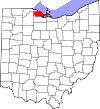
|
| Paulding County
|
125
|
Paulding |
Apr 1, 1820 |
Darke County |
John Paulding (1758–1818), captor of spy John André during the Revolutionary War
|
18,706
|
416.26 sq mi
(1,078 km2) |

|
| Perry County
|
127
|
New Lexington |
Mar 1, 1818 |
Washington, Fairfield, and Muskingum Counties |
Commodore Oliver Hazard Perry (1785–1819), a naval officer of the War of 1812
|
35,551
|
409.78 sq mi
(1,061 km2) |

|
| Pickaway County
|
129
|
Circleville |
Mar 1, 1810 |
Ross, Fairfield, and Franklin Counties |
A misspelling of the Piqua tribe, a branch of the Shawnee
|
61,086
|
501.91 sq mi
(1,300 km2) |

|
| Pike County
|
131
|
Waverly |
Feb 1, 1815 |
Ross, Scioto, and Adams Counties |
General Zebulon M. Pike (1779–1813), a War of 1812 officer and discoverer of Pikes Peak in Colorado in 1806
|
27,001
|
441.49 sq mi
(1,143 km2) |
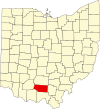
|
| Portage County
|
133
|
Ravenna |
Jun 7, 1807 |
Trumbull County |
Derived from an Indian portage
|
162,665
|
492.39 sq mi
(1,275 km2) |

|
| Preble County
|
135
|
Eaton |
Mar 1, 1808 |
Montgomery and Butler Counties |
Captain Edward Preble (1761–1807), a Naval commander in the Revolutionary War
|
40,556
|
424.80 sq mi
(1,100 km2) |

|
| Putnam County
|
137
|
Ottawa |
Apr 1, 1820 |
Shelby County |
General Israel Putnam (1718–1790), a Revolutionary War officer
|
34,199
|
483.87 sq mi
(1,253 km2) |
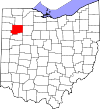
|
| Richland County
|
139
|
Mansfield |
Mar 1, 1808 |
Fairfield County |
Descriptive of the soil in the area
|
125,064
|
496.88 sq mi
(1,287 km2) |

|
| Ross County
|
141
|
Chillicothe |
Aug 20, 1798 |
Adams and Washington Counties |
Named for U.S. Senator from Pennsylvania James Ross by territorial governor Arthur St. Clair
|
76,501
|
688.41 sq mi
(1,783 km2) |
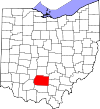
|
| Sandusky County
|
143
|
Fremont |
Apr 1, 1820 |
Huron County |
An Iroquois word meaning "cold water"
|
58,709
|
409.18 sq mi
(1,060 km2) |

|
| Scioto County
|
145
|
Portsmouth |
May 1, 1803 |
Adams County |
Scioto River; Scioto is a Wyandot Indian word meaning "deer"
|
71,969
|
612.27 sq mi
(1,586 km2) |
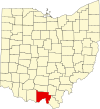
|
| Seneca County
|
147
|
Tiffin |
Apr 1, 1820 |
Huron County |
Seneca Indians, who had a reservation in the county area at the time
|
54,527
|
550.59 sq mi
(1,426 km2) |
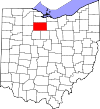
|
| Shelby County
|
149
|
Sidney |
Apr 1, 1819 |
Miami County |
General Isaac Shelby (1750–1826), a Revolutionary War officer and Governor of Kentucky
|
47,765
|
409.27 sq mi
(1,060 km2) |
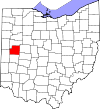
|
| Stark County
|
151
|
Canton |
Feb 13, 1808 |
Columbiana County |
General John Stark (1728–1822), a Revolutionary War officer; known as the "Hero of Bennington" for his exemplary service at the Battle of Bennington in 1777
|
372,716
|
576.14 sq mi
(1,492 km2) |

|
| Summit County
|
153
|
Akron |
Mar 3, 1840 |
Medina, Portage, and Stark Counties |
Its location at the highest elevation along the Ohio and Erie Canal
|
535,733
|
419.38 sq mi
(1,086 km2) |

|
| Trumbull County
|
155
|
Warren |
Jul 10, 1800 |
Jefferson and Wayne Counties |
Jonathan Trumbull (1710–1785), Governor of Connecticut when the county was organized
|
200,373
|
616.48 sq mi
(1,597 km2) |

|
| Tuscarawas County
|
157
|
New Philadelphia |
Mar 15, 1808 |
Muskingum County |
Tuscarawas River, meaning "open mouth river"
or
the Tuscarawas tribe who lived on the river
|
91,874
|
567.58 sq mi
(1,470 km2) |

|
| Union County
|
159
|
Marysville |
Apr 1, 1820 |
Delaware, Franklin, Logan, and Madison Counties |
Its formation by a union of four counties
|
69,637
|
436.65 sq mi
(1,131 km2) |

|
| Van Wert County
|
161
|
Van Wert |
Apr 1, 1820 |
Darke County |
Isaac Van Wart (1760–1828), captor of spy John André during the Revolutionary War
|
28,704
|
410.09 sq mi
(1,062 km2) |

|
| Vinton County
|
163
|
McArthur |
Mar 23, 1850 |
Athens, Gallia, Hocking, Jackson, and Ross Counties |
Samuel Finley Vinton (1792–1862), Ohio Statesman and U.S. Congressman
|
12,474
|
414.08 sq mi
(1,072 km2) |

|
| Warren County
|
165
|
Lebanon |
May 1, 1803 |
Hamilton County |
General Joseph Warren (1741–1775), a Revolutionary War officer
|
252,148
|
399.63 sq mi
(1,035 km2) |
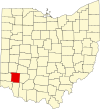
|
| Washington County
|
167
|
Marietta |
Jul 27, 1788 |
One of the original counties |
George Washington (1732–1799), commander of the Continental Army, president of the Constitutional Convention, and future President of the United States
|
58,577
|
635.15 sq mi
(1,645 km2) |
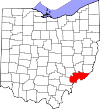
|
| Wayne County
|
169
|
Wooster |
Mar 1, 1812 |
Stark County |
General Anthony Wayne (1745–1796), a Revolutionary War officer
|
116,510
|
555.36 sq mi
(1,438 km2) |

|
| Williams County
|
171
|
Bryan |
Apr 1, 1820 |
Darke County |
David Williams (1754–1831), captor of spy John André during the Revolutionary War
|
36,591
|
421.74 sq mi
(1,092 km2) |

|
| Wood County
|
173
|
Bowling Green |
Apr 1, 1820 |
Refactored from non-county territory |
Eleazer D. Wood (1783–1814), founder of Fort Meigs
|
132,650
|
617.32 sq mi
(1,599 km2) |

|
| Wyandot County
|
175
|
Upper Sandusky |
Feb 3, 1845 |
Marion, Crawford, and Hardin Counties |
Wyandot Indians
|
21,457
|
405.61 sq mi
(1,051 km2) |
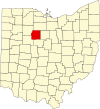
|
